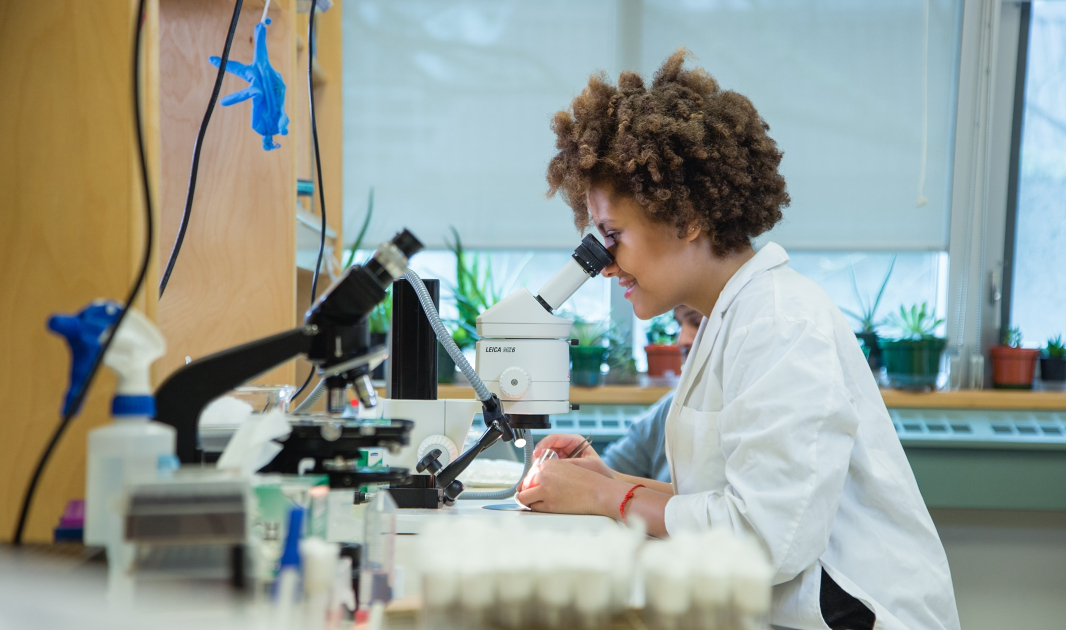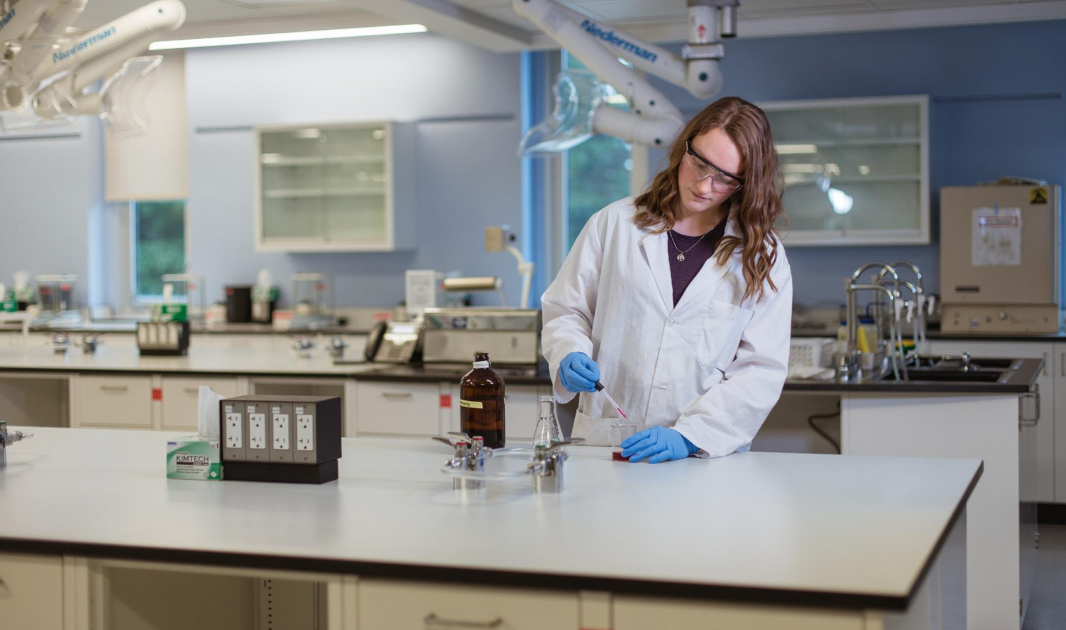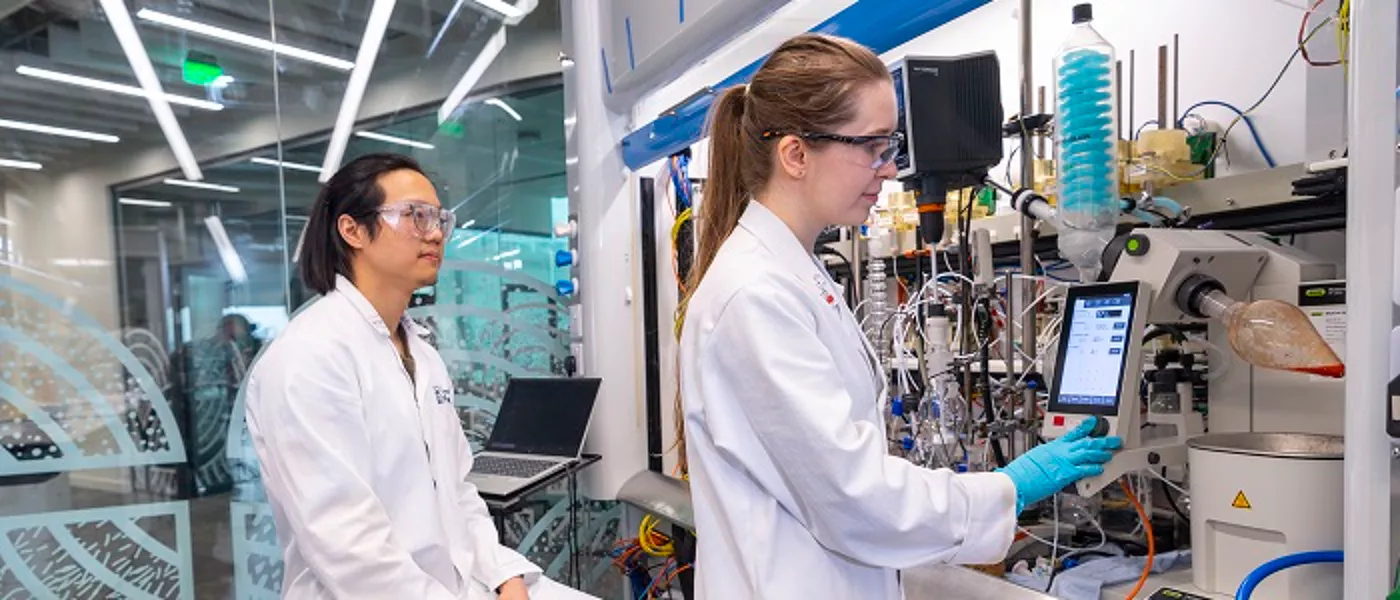Laboratories play a crucial role in our lives. Within these high-tech spaces, ground-breaking scientific breakthroughs are continually being made, whether that be by happy accident or via targeted trials.
For scientists, laboratory managers, researchers and life sciences teams to flourish, they require specialised environments which are practical and productive but also creative and collaborative. This laboratory design can be achieved through thoughtful planning in terms of layout, technology, equipment, furniture and furnishings.
At Evolve, we love to work alongside our life sciences clients to deliver innovative laboratory designs specific to their bespoke business needs, from wet labs requiring specialised air extraction to tackle potentially harmful chemicals, to electronics labs needing multiple power-connected worktops.

1. Let the scientists take the lead
Before you can design a laboratory, you have to understand its needs. Is it a wet lab or a dry lab? Will it be handling volatile chemicals or need cold storage facilities? What about soundproofing, vibration control or plans for future expansion?
a. Gather the stakeholders together – including lab managers and users, scientists and maintenance staff – and discuss function, workflows and processes.
b. Ascertain the critical requirements, from space needs to temperature control, air changes and pressure regimes, to create the most efficient laboratory blueprint.
c. Establish a shared vision, and use it as your guide throughout the design and fit out process to ensure it is executed concisely.
2. Lab safety requirements
Safety is a top priority in laboratory design, with the vast array of different chemicals and gases in regular use elevating the risk of fire or injury. Consider the following five steps as a minimum:
a. Ensure you have a robust chemical management strategy built into your design plan, especially if the substances being handled are hazardous, flammable or toxic.
b. Include chemical storage ‘control areas’, biosafety cabinets and emergency shower/eye wash stations.
c. Install fire protection and detection systems and clearly signpost fire exits.
d. Procedures should also be established for the safe transportation of chemicals in and out of the laboratory.
e. Include fume hoods, which help exhaust harmful vapours, gases and aerosols during research, whilst providing a protective shield between the scientist and the chemical reaction.
Evolve’s in-house mechanical and electrical experts can advise on safe laboratory procedures, including oxygen depletion monitoring systems, extraction and cooling solutions.
3. Adequate laboratory airflow
Let’s talk HVAC – which stands for Heating, Ventilation and Air Conditioning. Crucially, all three need to be at optimum levels in laboratory design to create both a safe and comfortable environment for research to take place.
The ventilation component of HVAC supplies fresh, clean air to the laboratory to displace contaminated air and dilute it to safe levels. How much ventilation your laboratory needs depends entirely on the type of work it does, and air quality may differ from one room to the next. So, rooms with fume cupboards and higher containment, for example, will need a greater amount of air changes.
Natural ventilation can also be an option for some laboratories, though windows should be fitted with insect screens, to ensure bugs (which can carry diseases) do not enter the laboratory setting.
Bolster staff wellbeing by giving them access to fresh air too, providing a refuge away from the strict clinical environment, perhaps on balconies or in designated outdoor areas with pleasant seating and greenery.

4. Abundant light in the lab
Laboratories need specific lighting, which is generally far higher in luminance than your average office. However, just like ventilation, lighting levels for laboratories vary according to their purpose.
Also, with the trend for lab design moving towards creating more flexible spaces, then collaboration areas may have different lighting requirements to close-work zones, which is where a layered lighting system works best. This approach uses overhead lights combined with task lights to meet prescribed levels.
What to consider when choosing laboratory lighting
- When choosing lighting, remember to bear in mind the finish colours of floors, ceilings and walls, to minimise glare and reduce the risk of eye fatigue.
- On top of artificial lighting, an abundance of natural light can do wonders for staff morale (boosting health and productivity), so let the sun shine in through floor-to-ceiling windows or large sky lights, where possible.
- If you’re designing a laboratory which has no access to natural light, consider specialised lighting which mimics circadian rhythms, helping staff to perform more efficiently in the day and sleep better at night.
5. Layout and laboratory furniture
Whatever the nature of your laboratory, its layout and furniture should enable scientists and researchers to work as smoothly and comfortably as possible.
Benches used for admin work and simple preparation should ideally be positioned around perimeter walls to improve access and workflow.
This also allows ample floor space for mobile equipment to be transported through the laboratory safely.
Wet labs
Commonly used for manipulating biological matter and chemicals – will need sinks, fume hoods and piped gases plumbing, plus chemical-resistant countertops (preferably incorporating a lip to avoid liquid-run off).
Incorporate flexible engineering services to supply air, water, electricity and vacuum systems, with easy connects and disconnects at walls for fast equipment hook-ups.
Dry labs
Which are predominantly electronics-focused – should include mobile storage, adjustable shelving, and multiple electric and data cabling access points.
To avoid clutter on worktops incorporate overhead cabinets and under-bench storage, with agile shelving options which can be altered in line with each new project.
Lab work is often undertaken whilst standing, however when it’s time to take a seat, the appropriate seating is important. Often draughtsman height chairs are chosen, which allows technicians to sit, perch or stand as needed.
Height adjustable lab benching is also available, but the furniture should be carefully selected based on how it will be used. Our expert team at Evolve can guide you through the available options based on the specific needs of your organisation.
6. Breakout spaces
Laboratories are controlled, clinical environments, where scientists, lab managers and researchers often fly solo. Yet some of the best results are achieved through collaborative thinking, so include warm and comfortable ‘breakout spaces’ in your laboratory design to spark a meeting of brilliant minds.
These could be social hubs, decorated in uplifting hues and filled with lush planting, to harness the positive power of ‘collision’ spots, dotted along circulation routes where employees’ cross paths and share ideas. Encourage these encounters by adding built-in window seats, little nooks, wi-fi connection and, of course, tea and coffee facilities!
How Evolve can help with you laboratory design
If you’re a life sciences business wondering where to start with your laboratory design, Evolve offers a full turnkey service, from concept to completion.
Not only do we carefully plan and design your laboratory space, but our in-house teams can devise dynamic office facilities to complement lab designs, manage relocation, supply bespoke laboratory furniture and set up your mechanical and electrical services.
Get in touch to find out how we can design a specialised space for you which supports great minds as they create and innovate.

You might also be interested in
All the latest news, ideas and insights from Evolve
What can we do for your business?
However big or small your business, we could make life easier. Our specialists have all the skills needed to allow your new science laboratory project to thrive. From initial design, supply and installation of furniture to providing all associated building services, Evolve has the in-house expertise to deliver on time and within budget.
We can help you determine the best way to make use of your available space while prioritising safety, space, and accessibility. Evolve has supplied and fitted lab furniture and accessories to a range of companies and institutions over the years. Major projects in recent years include:
- Brewing giant Farsons
- Dubai Police forensic science laboratories
- University of Malta
- Semiconductor firm ST Microelectronics
- Pharma companies Aurobindo, Actavis and Pharmacare
- European Commission science laboratories in Brussels
- Malta College of Arts, Science and Technology
- Montekristo Wine Estates
- Environment services agency Wasteserv
- Malta’s state-run public health laboratory
We also offer a range of additional services, including fume management, network cabling, electricity distribution and testing, plumbing and testing both for water and gases as well as all drains and speciality gases.
We’re ready to be by your side to help you design, equip and maintain a fully EU-compliant lab for your next project. For a complete, professionally-delivered project from initial design through to completion, get in touch with Evolve today.


